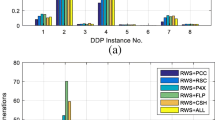Abstract
A fundamental problem in computational biology is the restriction site mapping. When a particular restriction enzyme is added to a DNA, the DNA strand is cut at particular restriction sites. The goal of the restriction site mapping is to determine the location of every site for a given enzyme. Using gel electrophoresis, one can find the distance between each pair of restriction sites. In the partial digest problem (PDP), we are given these distances arising from digestion experiments by using only one enzyme, and we are asked to compute the locations of all restriction sites. Several approaches, including pseudo-polynomial time algorithm and backtracking algorithm have been proposed to tackle this problem. In this paper we propose a new model for this problem. Based on this model, we present a new branch and bound algorithm for partial digest problem. In comparison with the backtracking algorithm presented by Skiena, the new algorithm has very small search tree and so it is very efficient. The efficiency and advantages of this algorithm are also demonstrated by executing it on different types of instances. There exist some instances of PDP, where the Skiena’s algorithm requires exponential running time to solve them. The efficiency of our algorithm is also presented for these kind of problem instances.
Similar content being viewed by others
References
Bĺa zewicz J., Formanowicz P., Kasprzak M., Jaroszewski M., Markiewicz W.T.: Construction of DNA restriction maps based on a simplified experiment. Bioinformatics. 17(5), 398–404 (2001)
Cieliebak M., Eidenbenz S., Penna P.: Partial digest is hard to solve for erroneous input data. Theor. Comput. Sci. 349(3), 361–381 (2005)
Dakic, T.: On the Turnpike problem. PhD thesis, Simon Fraser University (2000)
Lemke, P., Werman, M.: On the complexity of inverting the autocorrelation function of a finite integer sequence, and the problem of locating n points on a line, given the \({{n \choose 2}}\) unlabelled distances between them. Preprint 453, Institute for Mathematics and its Application IMA (1988)
Patterson A.L.: A direct method for the determination of the components of interatomic distances in crystals. Zeitschr. Krist. 90, 517–542 (1935)
Pevzner, P.A., Waterman, M.S.: Open combinatorial problems in computational molecular biology. In: Proceedings of the 3rd Israel Symposium on Theory of Computing and Systems (ISTCS1995), pp. 158–173 (1995)
Skiena, S.S., Smith, W., Lemke, P.: Reconstructing sets from interpoint distances.In: Proceedings of the 6th ACM Symposium on Computational Geometry (SoCG 1990), pp 332–339 (1990)
Skiena S.S., Sundaram G.: A partial digest approach to restriction site mapping. Bull. Math. Biol. 56, 275–294 (1994)
Zhang Z.: An exponential example for a partial digest mapping algorithm. J. Comput. Biol. 1(3), 235–239 (1994)
Author information
Authors and Affiliations
Corresponding author
About this article
Cite this article
Nadimi, R., Fathabadi, H.S. & Ganjtabesh, M. A fast algorithm for the partial digest problem. Japan J. Indust. Appl. Math. 28, 315–325 (2011). https://doi.org/10.1007/s13160-011-0041-1
Received:
Revised:
Published:
Issue Date:
DOI: https://doi.org/10.1007/s13160-011-0041-1




